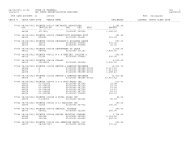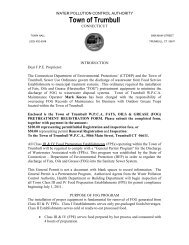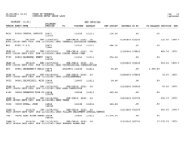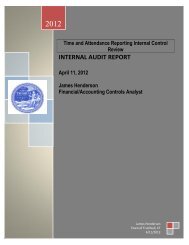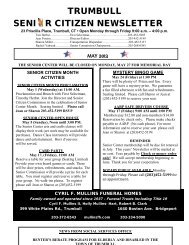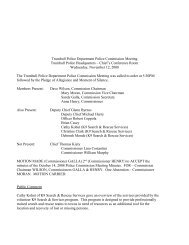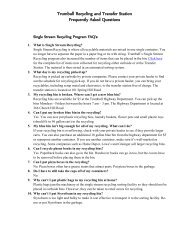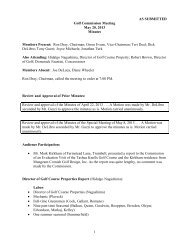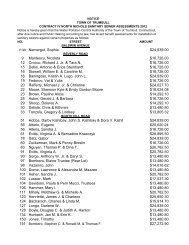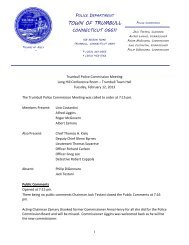Forensic Audit Report-WPCA Phase IV, Part B. Contract ... - Trumbull
Forensic Audit Report-WPCA Phase IV, Part B. Contract ... - Trumbull
Forensic Audit Report-WPCA Phase IV, Part B. Contract ... - Trumbull
Create successful ePaper yourself
Turn your PDF publications into a flip-book with our unique Google optimized e-Paper software.
<strong>Forensic</strong> Consulting Services <strong>Report</strong><br />
Town of <strong>Trumbull</strong>, Connecticut<br />
Page 34<br />
authority. The Town must recognize that if indeed the required expertise and dedication of adequate<br />
staff is not present or available within current Town employees, a solicitation of outside assistance<br />
should be an order of priority prior to moving forward with any future contracts of this type and<br />
magnitude.<br />
As a source of future reference, the Town may wish to explore the construction procedures and<br />
recordkeeping policies set forth by the State of Connecticut Department of Transportation (CTDOT)<br />
“Construction Manual”, “Municipal Manual”, “Construction <strong>Contract</strong> Bidding and Award Manual”<br />
and the “Construction Engineering and Inspection, Information Pamphlet for Consulting<br />
Engineers”. All four publications are available online through the CTDOT website. The Town<br />
should keep in mind however that these manuals are fairly detailed and were formulated for a full<br />
range of projects, both in size and type. As such the Town may wish formulate their own set of<br />
policies and procedures using these and other manuals merely as a guide thereby producing a more<br />
concise and simplified approach for construction management that may better suit their overall<br />
needs.<br />
Also to establish a sense of accountability for <strong>Contract</strong> 3 it may be beneficial for the Town to<br />
conduct a thorough and detailed accounting of the entire contract both in regards to quantities and<br />
cost prior to making any final payments to the <strong>Contract</strong>or and completing a project close-out. As<br />
part of this accounting procedure, quantity takeoffs and dollar values should be produced and<br />
analyzed for all design related drawings, supplemented by any as-built records available thereby<br />
confirming not only the basis of <strong>Contract</strong> 3, but also any additional work related to the “Jog Hill<br />
Extension” and/or other elements of “Extra Work” paid for under individual change orders as well as<br />
the “Supplementary Unit Prices” of the contract. Once this is complete, a comparison of quantities<br />
and cost may then be performed analyzing and confirming a consistency with the expenditures<br />
indicated under the most recent Application for Payment. Any significant deviations in recorded<br />
quantities or their related costs should be examined further either by extending record research,<br />
performing additional interviews with the Town’s field representative(s), the contractor and/or the<br />
design engineer of record seeking explanations, onsite field investigations, inspections and/or<br />
measurement surveys, or a combination of all to insure and document an accurate accounting of<br />
<strong>Contract</strong> 3.<br />
One of the primary and significant examples of substandard recordkeeping and a lack of field<br />
documentation relates to the installation of the “8-inch PVC Sewer Trench Drain”. Although a total<br />
of 46,348 linear feet of trench drain was apparently installed throughout the project area and paid for<br />
under Pay Item No. 32 and Change Order 15, there does not appear to be any reliable field<br />
documentation and/or as-built information to confirm the exact extent and locations of the pipelines<br />
installed. The total cost expended for this item of work equals $926,960.<br />
Another example relates to those items of work that were apparently completed by the <strong>Contract</strong>or<br />
and paid for by the Town under the “Supplementary Unit Prices” of <strong>Contract</strong> 3. As stated elsewhere<br />
in this report, utilization of the “Supplementary Unit Prices”, which were established for contractual<br />
convenience and contained under the original contract for elements of “extra work” when so duly<br />
authorized, were allowed to be used and charged to <strong>Contract</strong> 3 in an undocumented, open-ended and



